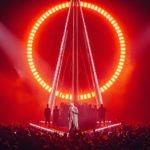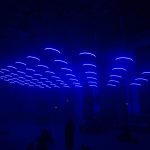A funny thing happened on the way to the top of the grand master fader. I found out that it not only goes up, but it also comes down. It was a complete accident, but it turned out to be a discovery that was right up there with the time I found out my VCR wasn’t supposed to flash “12:00.”
When a tour manager voiced concerns about the pacing of a show, I listened intently as he described what he wanted to see. He wanted the show to build. He wanted a steady building of lighting looks, punctuated by a climax. He wanted to hold back the best for last. In short, he wanted the impossible.
Ordinarily, his would have been a perfectly reasonable request. But in this case I was using some new toys to light a hard-rocking band. I found it as close to impossible as you could possibly get to not get excited about the music and throw every programming trick you have into the mix. And that was just the opening act. So you see, there was nothing left in reserve for the headliner. This was a problem.
After pondering it for a while, I decided to take drastic action. When the show started and the opening band took the stage, I closed my eyes, said a little prayer, swallowed hard, and did it. I actually lowered the playback fader to half.
Not having enough time to reprogram the songs in the show, I reasoned that by lowering the lighting levels, I could lower the energy of the show. Less light equals less energy and excitement, right? Wrong. In this case, it actually had the opposite effect.
Excuse me? You mean to tell me you lowered the lighting levels and it raised the energy level on the stage? Have you been hanging out with Mel Gibson? Lucy, you have some ‘splainin’ to do.
Let me explain. Although I lowered the lighting levels, the projection was on another playback fader. It was left at full. Right before my eyes, what I saw was the relative levels between the stage lighting and the projection on the backdrop swapping places. What started as very strong lighting with some projection in the background, became very strong projection with some lighting in the foreground. It completely transformed the visuals.
To my eyes, if it wasn’t pure magic, then it was at least a really good illusion.
It’s very easy to get caught up in illumination inflation. Automated lights are dropping in price relative to their light output, and today it’s much more affordable for a production to have the latest crop of brighter, more efficient automated lights and Lekos. And today’s 700-watt fixtures put out about as much light, in general, as many 1200-watt fixtures do. Do we really need all this firepower?
We see by a combination of illumination and contrast — or in simple terms, light and dark. And as lighting designers we sometimes forget about the other half of the equation, the dark, or the contrast. The human eye is an incredibly complex instrument. It has an ability to adjust itself and compensate for varying levels of illumination. When the lighting level goes down, the iris opens up to allow more light to reach the part of your eye that senses it. So the contrast between light and dark might be more important to a composition than the quantity of light in it.
Tony Award-winning lighting designer Jules Fisher recently told me that the lighting levels on Broadway have risen steadily since he started working there several years ago. He suggested that it would be an interesting exercise to take some old lighting plots and calculate the illuminance on stage and compare it to a modern day production. I think he estimated that it has increased two- or three-fold. Why is that? Do we really need that much light, or are we seduced by the power and punch of a big, powerful beam of light?
This is my hypothesis, and I would love to be proven wrong about this, so don’t be shy. As the lighting manufacturers continue to produce brighter and less expensive (relative to the light output) lights, optical engineers are increasingly making design decisions on our shows.
We are to the point where we have enough light on stage; now we’re just rearranging the balance between the sources. When you spec a particular light on a show, you can be sure that the programmer will use it at its full output without dimming it. So the determining factor, as far as illumination levels are concerned, is how bright the factory can make it. What should be the designer’s decision — how much light do I want on this subject, object or background? — is being determined by the optical engineer who designs the luminaire.
It’s not the manufacturer’s fault. They are simply feeding our need for speed. The more horsepower we can get, the better. We just continue to push the faders to the top of the range, and we’re forgetting to balance our sources. If our profile spots and color washes are washing out our followspots, or vice versa, we wouldn’t know it, because we’re too intent on squeezing out every last iota of candle power from our sources. Never mind that you can’t see the projection.
From now on I’m going to work harder to remember my objective, which is to create effective lighting that looks great. I won’t be afraid to turn down a fader or three. Even if my fader goes to 11, I’m going to try it on five. I want to let my eyes do the work while I balance the scene, and maybe those projections that I thought were too weak will pop like they should.
This is especially important in the age of convergence with digital lighting and the new crop of pan and tilt yokes for projectors. Maybe we don’t need 20K ANSI lumen projectors on every show. Maybe a 5K will do.
After this experience, when I hear someone say a projector isn’t bright enough, what I hear is, “I don’t know how to balance my sources.” I’ll bet their VCR is flashing “12:00,” too.


